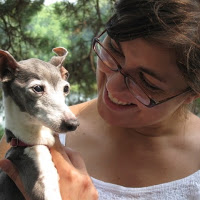by Mary Kate Hurley
for the first time in my graduate school career, I wasn't able to make it to Kalamazoo. My lovely co-bloggers did, and Jeffrey has posted an initial account of the fun the rest of us missed. In the spirit of the GW MEMSI panel , though, I'd like to offer my own little musing on one of the final scenes of the poem Beowulf. But go read the other posts about the conference now!
Revision is a funny thing. I’d imagine anyone who has written a dissertation has had one chapter that flummoxed her beyond all reason. I’d also imagine that often that chapter takes on a life of its own that might even be larger than the dissertation. After several false starts and a number of revisions, I recently managed to make my Beowulf chapter into something I think I might eventually be pretty happy with. I’d like to re-read the poem about ten more times before I revise the chapter into an article (which I think will be its ultimate destination) but for now, it stands as one of the most frustrating and most fulfilling things I think I’ve ever managed to write. If I ever write a book on Beowulf (a fate I truly hope to avoid), this chapter will be part of the reason.
Part of what’s so funny about revision is that there are whole swathes of the poem that I keep returning to and seeing with fresh eyes. As I made my final substantial revisions to the chapter late last semester, I found something I’d missed in my initial readings. There’s a section of the poem called the Beasts of Battle, a short little set-piece that falls right in the middle of the Messenger’s speech. Describing what will happen after the Swedes destroy the Geats on the field of battle, the Messenger tells us:
ac se wonna hrefn
fus ofer fægum fela reordian,
earne secgan, hu him æt æte speow,
þenden he wið wulf wæl reafode.
(But the black raven, the bird over the fated men, will tell, will say to the eagle, how he succeeded at the meal, when he with the wolf plundered the slaughtered ones, 3024-3027.)
One of the things I’ve been trying to do with Beowulf is to reimagine how the poem might be read. We’re all familiar with the mourning tone the end of the poem sets. Everyone, we are told, will die either soon or late, and though the poem ends with Beowulf’s personal victory over the dragon, the price of that victory for his people is all too clear. With Beowulf gone, the enemies of the Geats will destroy them. The Beasts of Battle are often read as just that—a moment that symbolizes human loss. But, I wonder, what if there’s a larger picture that allows a longer view of the world within the poem, exceeding the loss that permeates its human subject matter? And—crucially to the larger argument of the chapter—what if it’s precisely that larger picture that makes the world of the humans in the poem so endlessly painful and brutal, their achievements so short-lived?
Hence my interest in the raven and the wolf. If the raven “succeeded at the meal,” then there seems to be an intimation that humans can be considered part of a larger configuration than just the endlessly failing human communities the poem portrays. In the chapter, I borrow the Actor-Network theory term collectivity for this, but we could just as easily call it an eco-system or a network. Even the term “reafian” suggests the ways in which the animals here participate in an action that allows them a degree of agency previously granted only to the humans in the poem. The use of “reafian” provides a disjunctive echoing of two earlier uses of the same verb. At 1212, the first use of reafian describes the actions undertaken by the Frisian warriors after a failed attack by Hygelac: “worse battle-warriors plundered the slaughtered” (wyrsan wig-frecan wæl reafeden). Frisian warriors plunder Geatish ones. At line 2985, a similar usage occurs in Wulf and Eofor’s defeat of Ongenþeow: “Then the warrior plundered the other, took from Ongenþeow his iron byrnie, his hard sword hilt and also his helmet” (Þenden reafode rinc oðerne, nam on Ongenðio iren-byrnan heard swyrd hilted ond his helm somod). Human warriors take the things that matter in a human world by plundering bodies for war-gear. The wolf and the raven, on the other hand, plunder human bodies for what such creatures value: a meal of meat.
And in the end, the raven and the wolf seem to be some of the only victors we see in the poem. Heorot burns. The Geats, and their leader Wiglaf, will be annihilated. Beowulf is dead. Even the dragon met his end. But the raven and wolf disrupt the poem’s studied meditation on death and ending. Perhaps they even offer a glimpse of the world in which Beowulf and his Geatish warriors operate – where animals and metals exist on a similar plane as the humans who use and interact with them, and where sometimes these creatures and things “succeed” where humans and human institutions fail. Maybe beyond the poem, and beyond Beowulf himself – there’s a whole world.
Tuesday, May 17, 2011
Ravens, Wolves and a different Beowulf
Posted by Mary Kate Hurley at 3:12 PM 7 comments
Labels: Beowulf, dissertation
Subscribe to:
Comments (Atom)


